Integrated Flood Forecasting and Warning System against Flash Rainfall in the Small-Scaled Urban Stream
Abstract
:1. Introduction
2. The Integrated Flood Forecasting and Warning System
2.1. Short-Term Inundation Prediction
2.2. Very Short-Term Inundation Prediction
2.2.1. Rainfall Forecasting by Radar
2.2.2. Construction of the Rainfall-Runoff Model
3. Study Area and Data Processing
3.1. Study Area and Runoff Model
3.2. Hydrological Time Series Data
4. Application and Evaluation of Integrated System
4.1. Model Application
4.1.1. Application of Short-Term Inundation Prediction
4.1.2. Application of Very Short-Term Inundation Prediction
4.1.3. Evaluation of the Integrated Flood Forecasting and Warning System
5. Conclusions
Author Contributions
Funding
Acknowledgments
Conflicts of Interest
References
- Karamouz, M.; Hosseinpour, A.; Nazif, S. Improvement of urban drainage system performance under climate change impact: Case study. J. Hydrol. 2010, 16, 395–412. [Google Scholar] [CrossRef]
- Wu, X.S.; Wang, Z.L.; Guo, S.L.; Liao, W.L.; Zeng, Z.Y.; Chen, X.H. Scenario-based projections of future urban inundation within a coupled hydrodynamic model framework: A case study in Dongguan City, China. J. Hydrol. 2017, 547, 428–442. [Google Scholar] [CrossRef]
- IPCC. Climate Change 2014: Synthesis Report; Pachauri, R.K., Meyer, L.A., Eds.; IPCC: Geneva, Switzerland, 2014; pp. 1–151. [Google Scholar]
- Kim, S.M.; Tachikawa, Y.; Takara, K. Recent flood disasters and progress of disaster management system in Korea. Annu. Disaster Prevent. Res. Inst. Kyoto Univ. 2007, 50, 15–31. [Google Scholar]
- Blong, R. A Review of Damage Intensity Scales. Nat. Hazards 2003, 29, 57–76. [Google Scholar] [CrossRef]
- Seoul Metropolitan City. River Emergency Evacuation Notification System. 2013. Available online: http://203.142.217.120/ (accessed on 19 August 2020).
- Lin, G.F.; Lin, Y.H.; Chou, Y.C. Development of a real-time regional-inundation forecasting model for the inundation warning system. J. Hydroinform. 2013, 15, 1391–1407. [Google Scholar] [CrossRef]
- Chang, L.C.; Chang, F.J.; Yang, S.N.; Kao, I.F.; Ku, Y.Y.; Kuo, C.L.; Amin, I.M.Z.M. Building an intelligent hydroinformatics integration platform for regional flood inundation warning systems. Water 2018, 11, 9. [Google Scholar] [CrossRef] [Green Version]
- Berne, A.; Delrieu, G.; Creutin, J.D.; Obled, C. Temporal and spatial resolution of rainfall measurements required for urban hydrology. J. Hydrol. 2004, 299, 166–179. [Google Scholar] [CrossRef]
- Bruni, G.; Reinoso, R.; Giesen, N.C.; Clemens, F.H.L.R.; Veldhuis, J.A.E. On the sensitivity of urban hydrodynamic modelling to rainfall spatial and temporal resolution. Hydrol. Earth Syst. 2015, 19, 691–709. [Google Scholar] [CrossRef] [Green Version]
- Einfalt, T.; Arnbjerg-Nielsen, K.; Golz, C.; Jensen, N.E.; Quirmbachd, M.; Vaes, G.; Vieux, B. Towards a roadmap for use of radar rainfall data in urban drainage. J. Hydrol. 2004, 299, 186–202. [Google Scholar] [CrossRef]
- Foresti, L.; Reyniers, M.; Seed, A.; Delobbe, L. Development and verification of a real-time stochastic precipitation nowcasting system for urban hydrology in Belgium. Hydrol. Earth Syst. 2016, 12, 6831–6879. [Google Scholar] [CrossRef]
- Shi, X.; Gao, Z.; Lausen, L.; Wang, H.; Yeung, D.Y.; Wong, W.K.; Woo, W.C. Deep Learning for Precipitation Nowcasting: A Benchmark and a New Model. Available online: http://papers.nips.cc/paper/7145-deep-learning-for-precipitation-nowcasting-a-benchmark-and-a-new-model (accessed on 19 August 2020).
- Chang, F.J.; Chen, P.A.; Lu, Y.R.; Huang, E.; Chang, K.Y. Real-time multi-step-ahead water level forecasting by recurrent neural networks for urban flood control. J. Hydrol. 2014, 517, 836–846. [Google Scholar] [CrossRef]
- Kim, H.U.; Bae, T.S. Preliminary study of deep learning-based precipitation prediction. J. Korean Soc. Surv. 2017, 35, 423–430. [Google Scholar]
- Hu, C.; Wu, Q.; Li, H.; Jian, S.; Li, N.; Lou, Z. Deep learning with a long short-term memory networks approach for rainfall-runoff simulation. Water 2018, 10, 1543. [Google Scholar] [CrossRef] [Green Version]
- Kang, J.; Wang, H.; Yuan, F.; Wang, Z.; Huang, J.; Qiu, T. Prediction of precipitation based on recurrent neural networks in Jingdezhen. Atmosphere 2020, 11, 246. [Google Scholar] [CrossRef] [Green Version]
- Song, T.; Ding, W.; Wu, J.; Liu, H.; Zhou, H.; Chu, J. Flash flood forecasting based on long short-term memory networks. Water 2019, 12, 109. [Google Scholar] [CrossRef] [Green Version]
- Bergstra, J.; Bengio, Y. Random search for hyper-parameter optimization. J. Mach. Learn. Res. 2012, 13, 281–305. [Google Scholar]
- Hochreiter, S.; Schmidhuber, J. Long short-term memory. Neural Comput. 1997, 9, 1735–1780. [Google Scholar] [CrossRef]
- Kingma, D.; Ba, J. Adam: A Method for Stochastic Optimization. Available online: https://arxiv.org/abs/1412.6980 (accessed on 19 August 2020).
- He, K.; Zhang, X.; Ren, S.; Sun, J. Delving Deep into Rectifiers: Surpassing Human-Level Performance on Imagenet Classification. Available online: https://www.cv-foundation.org/openaccess/content_iccv_2015/html/He_Delving_Deep_into_ICCV_2015_paper.html (accessed on 19 August 2020).
- Atlas, D.; Ulbrich, C.; Marks, F.D.; Amitai, E.; Williams, C.R. Systematic variation of drop size and radar-rainfall relations. J. Geophys. Res. 1999, 104, 6155–6169. [Google Scholar] [CrossRef]
- Rinehart, R.E.; Garvey, T. Three dimensional storm motion detection by conventional weather radar. Nature 1978, 273, 287–289. [Google Scholar] [CrossRef]
- Kim, G.; Kim, J.P. Development of a short term rainfall forecast model using sequential CAPPI data. J. Korean Soc. Civ. Eng. 2009, 29, 543–550. (In Korean) [Google Scholar]
- Tolson, B.A.; Shoemaker, C.A. Dynamically dimensioned search algorithm for computationally efficient watershed model calibration. Water Resour. Res. 2007, 43, W01413. [Google Scholar] [CrossRef]
- Huff, F.A. Time distribution of rainfall in heavy storm. Water Resour. Res. 1967, 3, 1007–1019. [Google Scholar] [CrossRef]
- Guyon, I.; Makhoul, J.; Schwartz, R.; Vapnik, V. What size test set gives good error rate estimates? IEEE Trans. Pattern Anal. Mach. Intell. 1998, 20, 52–64. [Google Scholar] [CrossRef]
- University of Seoul, Integrated Flood Forecasting and Warning System Combined Inland-River. 2018. Available online: http://210.125.181.27:10001/IRFF/index.-do (accessed on 19 August 2020).
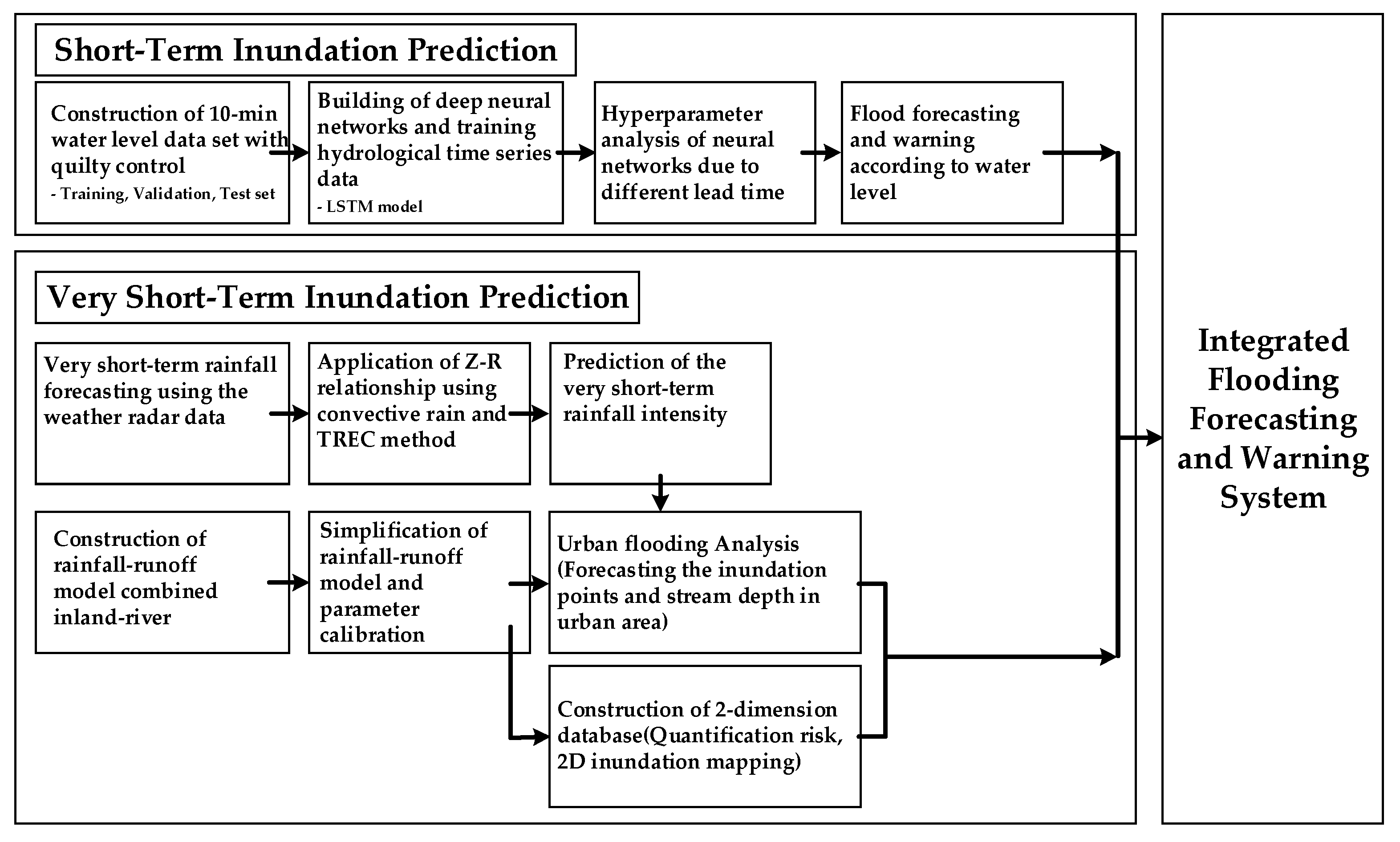
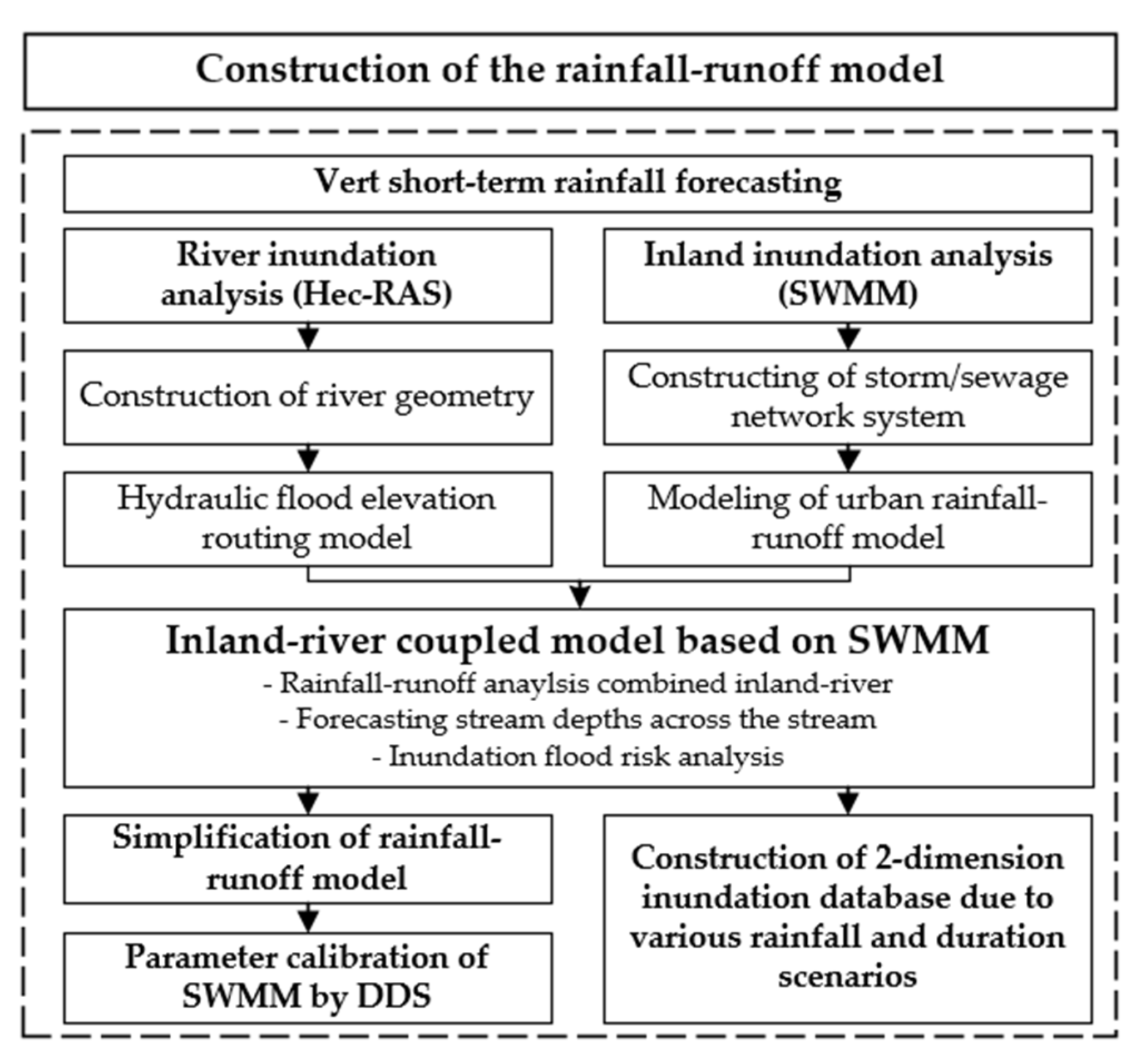

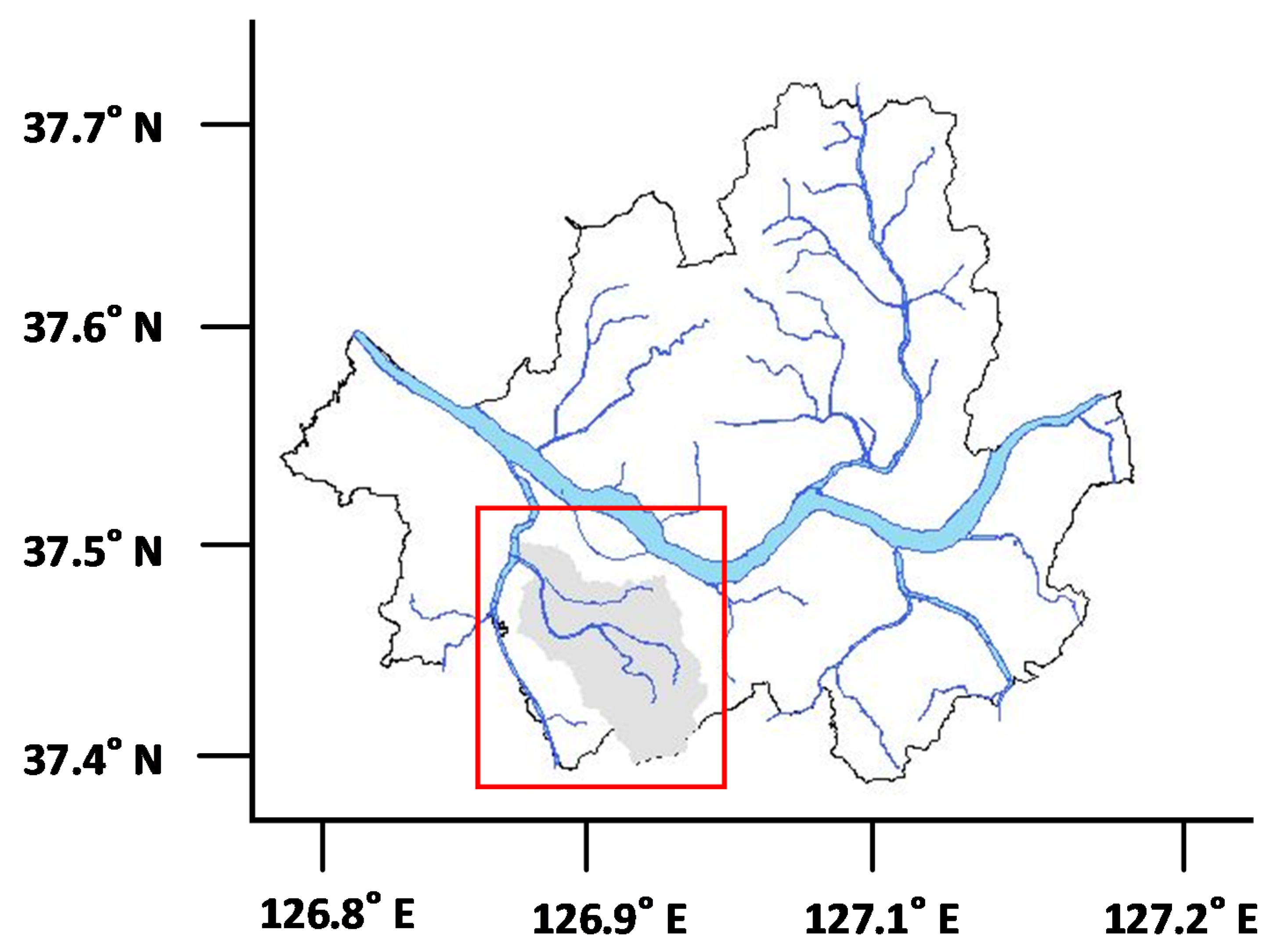

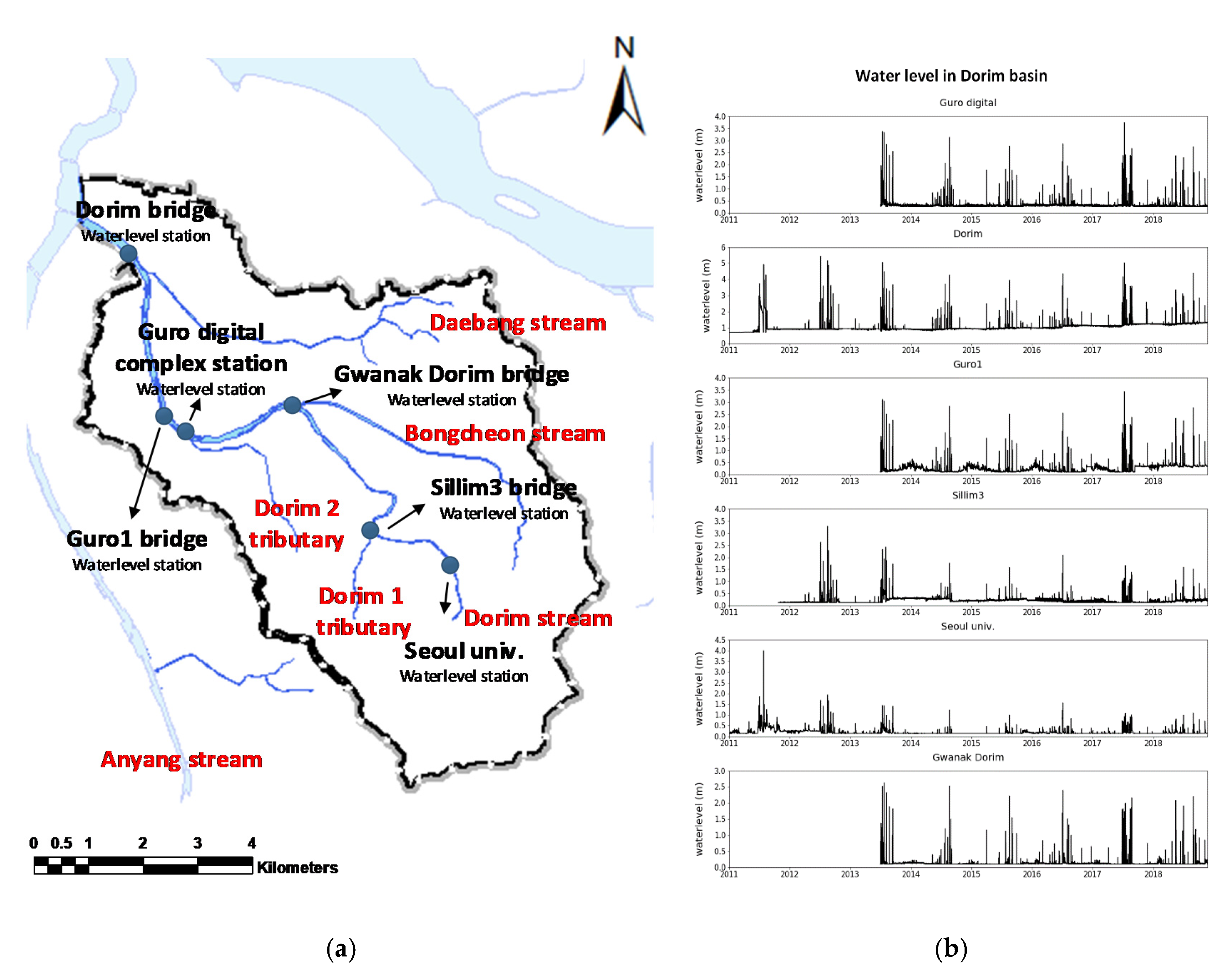

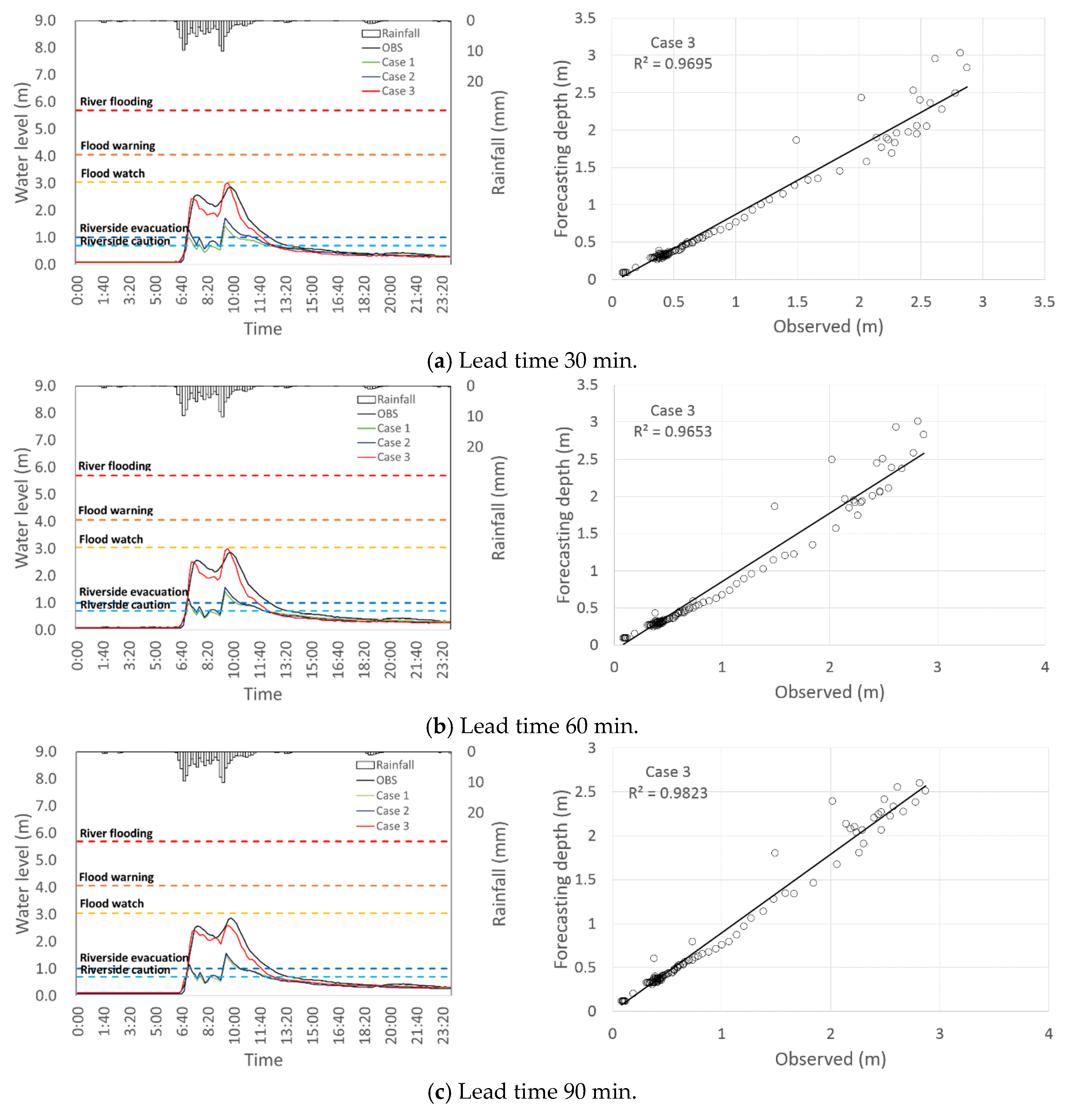

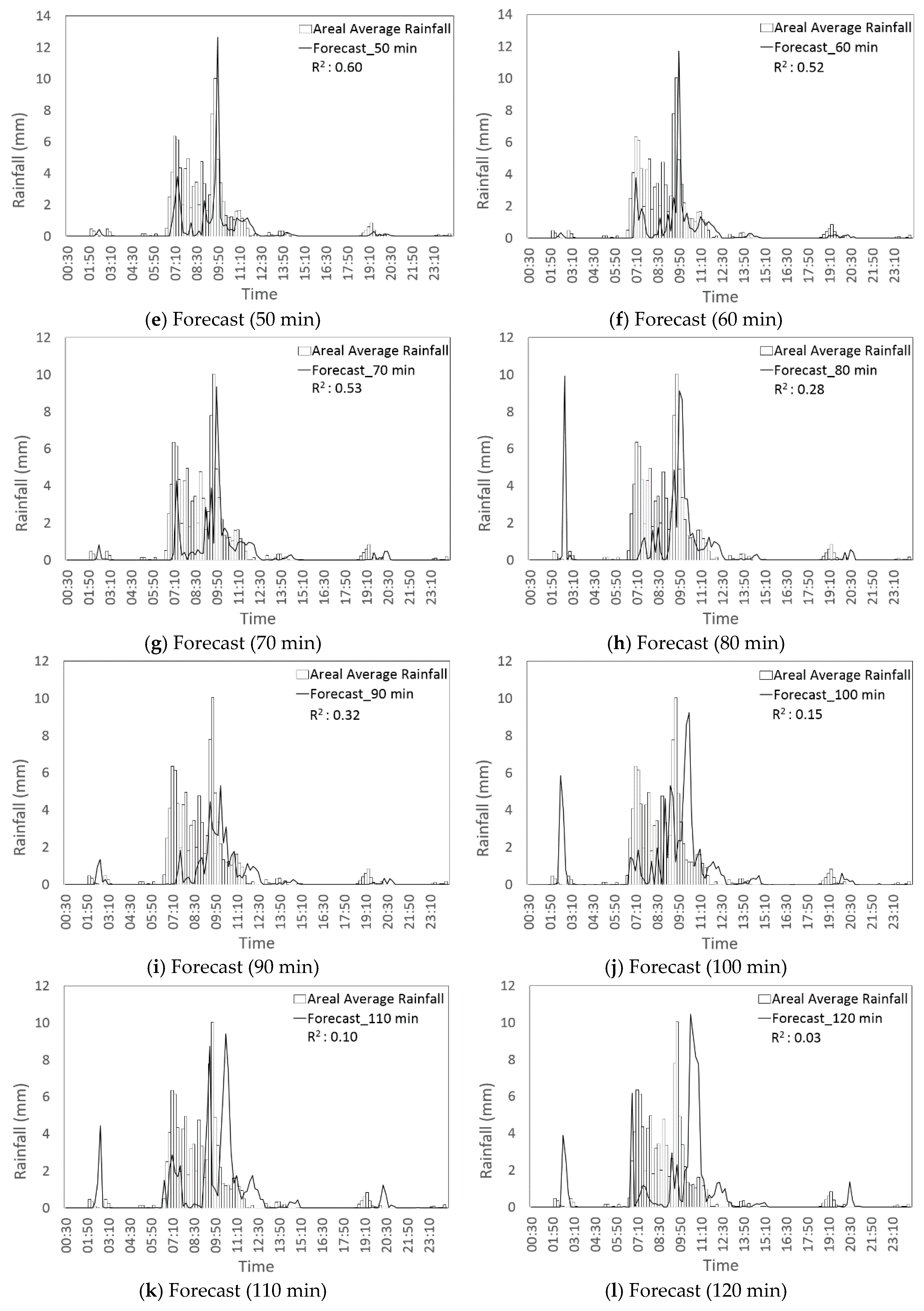
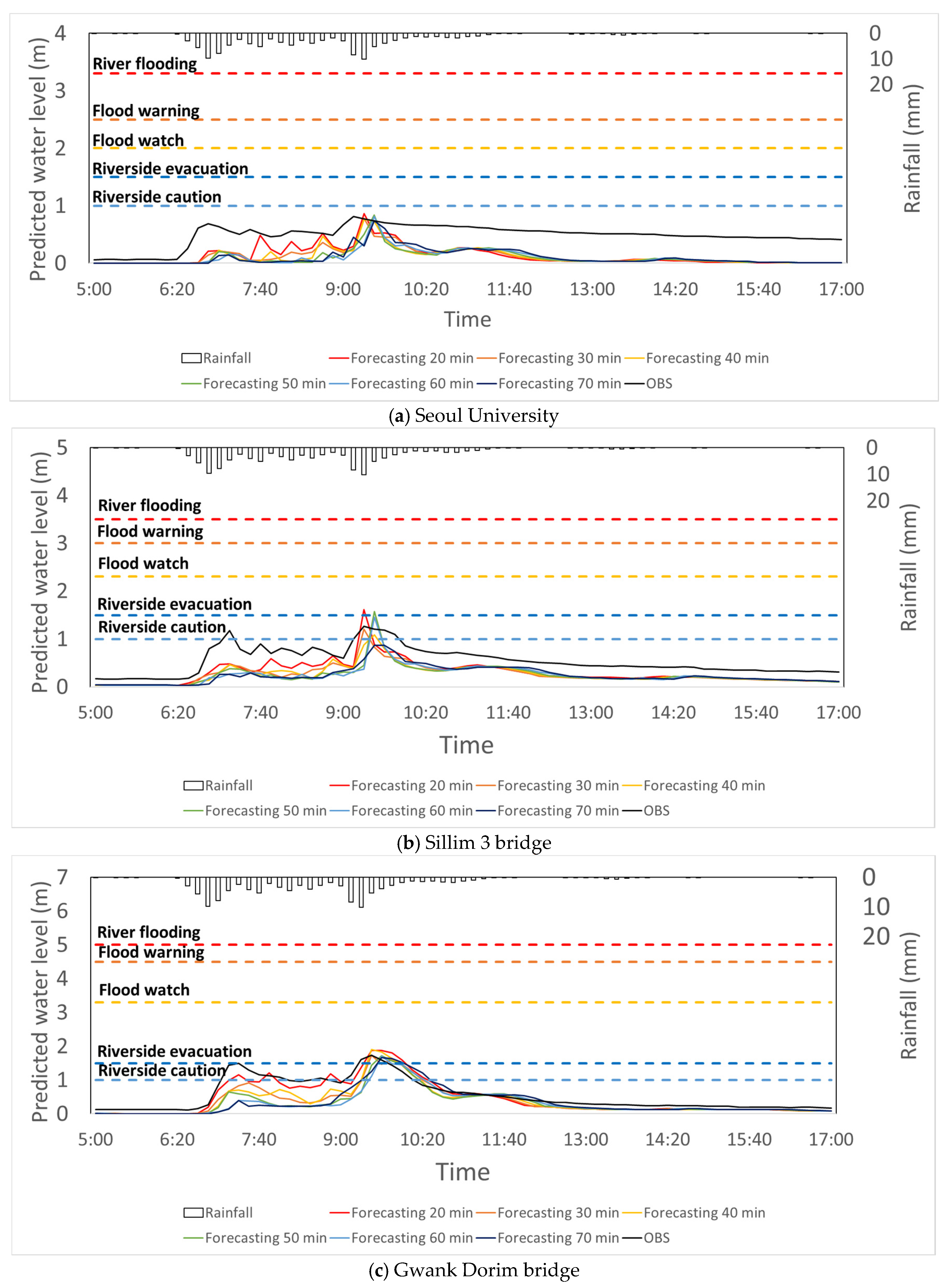


| Step | Detail Process |
|---|---|
| 1st step Checking of the initial condition | Searching the initial conduit and node Calculating the cross-sectional area of flow Checking the branch conduits and nodes Checking the outlet |
| 2nd step Calculating of the drainage area | Calculating the cumulative drainage area of all nodes from upstream point |
| 3rd step Calculating of the branch line and mainline | User can define the cumulative drainage area to distinguish branch line and main line |
| 4th step Calculating of the parameter | Calculating the parameters of nodes and conduits to be deleted in simplification process |
| 5th step Building of the drainage network | Building the simplified drainage network(.inp) |
| Step | Detail Process |
|---|---|
| 1st step | Define DDS input: Neighborhood perturbation size parameter, (0.2 is default) Maximum # of function evaluation, Vectors of lower, , and upper, , bounds for all D decision variables Initial solution, |
| 2nd step | Set counter to 1, i − 1, and evaluate objective function F at initial solution, F(: |
| 3rd step | Randomly select J of the D decision variables for inclusion in neighborhood, {}: Calculate probability each decision variable is included in {} as a function of the current iteration count: P(i) = 1 − ln(i)/ln() FOR d = 1, {} with probability P IF {} empty, select one random d for {} |
| 4th step | For j = 1, J decision variables in {}, perturb using a standard normal random variable, (0,1), reflecting at decision variable bounds if necessary: |
| 5th step | Evaluate F( |
| 6th step | Update iteration count, i = i+1, and check stopping criterion: IF i = m, STOP, print output (e.g., ELSE go to STEP 3 |
| Data Set | Station | Min | Max | Avg. | STDEV |
|---|---|---|---|---|---|
| Training set | Guro Digital Complex station | 0.27 | 3.73 | 0.31 | 0.103 |
| Gwanak Dorim bridge | 0.10 | 2.62 | 0.12 | 0.069 | |
| Sillim 3 bridge | 0.12 | 2.42 | 0.21 | 0.087 | |
| Seoul University | 0.14 | 1.56 | 0.16 | 0.067 | |
| Validation set | Guro Digital Complex station | 0.27 | 2.74 | 0.30 | 0.108 |
| Gwanak Dorim bridge | 0.08 | 2.20 | 0.13 | 0.086 | |
| Sillim 3 bridge | 0.04 | 1.59 | 0.20 | 0.060 | |
| Seoul University. | 0.01 | 1.08 | 0.12 | 0.089 | |
| Test set | Guro Digital Complex station | 0.23 | 2.57 | 0.29 | 0.091 |
| Gwanak Dorim bridge | 0.08 | 1.89 | 0.14 | 0.061 | |
| Sillim 3 bridge | 0.08 | 1.43 | 0.16 | 0.049 | |
| Seoul University | 0.01 | 0.99 | 0.11 | 0.074 |
| Case | Model | Data | Input Variable | Output Variable |
|---|---|---|---|---|
| Case 1 | LSTM | Water level | Wse (t), Wse (t − 1), ..., Wse (t − τ) | Wgdc (t + 3) Wgdc (t + 6) Wgdc (t + 9) |
| Case 2 | Wse (t), Wse (t − 1), ..., Wse (t − τ) Wsil (t), Wsil (t − 1), ..., Wsil (t − τ) | |||
| Case 3 | Wse (t), Wse (t − 1), ..., Wse (t − τ) Wsil (t), Wsil (t − 1), ..., Wsil (t − τ) Wgdb (t), Wgdb (t − 1), ..., Wgdb (t − τ) |
| Stations | Forecast 20 min | Forecast 30 min | ||||||
|---|---|---|---|---|---|---|---|---|
| R2 | RMSE | NSE | MAE | R2 | RMSE | NSE | MAE | |
| Seoul University | 0.35 | 0.34 | −1.71 | 0.30 | 0.41 | 0.35 | −1.73 | 0.30 |
| Sillim 3 birdge | 0.83 | 0.23 | 0.18 | 0.21 | 0.82 | 0.25 | 0.08 | 0.21 |
| Gwank Dorim bridge | 0.94 | 0.14 | 0.86 | 0.13 | 0.82 | 0.21 | 0.69 | 0.15 |
| Guro Digital Complex station | 0.93 | 0.40 | 0.48 | 0.35 | 0.85 | 0.46 | 0.31 | 0.38 |
| Stations | Forecast 40 min | Forecast 50 min | ||||||
| Seoul University | 0.34 | 0.35 | −1.82 | 0.31 | 0.36 | 0.36 | −1.91 | 0.32 |
| Sillim 3 birdge | 0.80 | 0.25 | 0.03 | 0.22 | 0.62 | 0.27 | −0.14 | 0.23 |
| Gwank Dorim bridge | 0.81 | 0.21 | 0.69 | 0.15 | 0.67 | 0.27 | 0.50 | 0.17 |
| Guro Digital Complex station | 0.83 | 0.46 | 0.30 | 0.38 | 0.71 | 0.52 | 0.10 | 0.41 |
| Stations | Forecast 60 min | Forecast 70 min | ||||||
| Seoul University | 0.36 | 0.35 | −1.89 | 0.31 | 0.37 | 0.35 | −1.80 | 0.31 |
| Sillim 3 birdge | 0.61 | 0.27 | −0.15 | 0.22 | 0.68 | 0.27 | −0.09 | 0.22 |
| Gwank Dorim bridge | 0.56 | 0.30 | 0.38 | 0.18 | 0.57 | 0.29 | 0.41 | 0.18 |
| Guro Digital Complex station | 0.60 | 0.56 | −0.04 | 0.42 | 0.55 | 0.57 | −0.06 | 0.41 |
| Flood Warning | Riverside Caution | Riverside Vacuation |
|---|---|---|
| Observation | 7:10 | 7:20 |
| REENS | 7:10 | 7:10 |
| LSTM (30 min lead time) | 6:50 (7:20) | 6:50 (7:20) |
| LSTM (60 min lead time) | 6:20 (7:20) | 6:20 (7:20) |
| LSTM (90 min lead time) | 5:40 (7:10) | 5:50 (7:20) |
| SWMM (20 min lead time) | 7:00 (7:20) | 7:00 (7:20) |
| SWMM (30 min lead time) | 7:00 (7:30) | 7:00 (7:30) |
| SWMM (40 min lead time) | 6:50 (7:30) | 6:50 (7:30) |
© 2020 by the authors. Licensee MDPI, Basel, Switzerland. This article is an open access article distributed under the terms and conditions of the Creative Commons Attribution (CC BY) license (http://creativecommons.org/licenses/by/4.0/).
Share and Cite
Lee, J.H.; Yuk, G.M.; Moon, H.T.; Moon, Y.-I. Integrated Flood Forecasting and Warning System against Flash Rainfall in the Small-Scaled Urban Stream. Atmosphere 2020, 11, 971. https://doi.org/10.3390/atmos11090971
Lee JH, Yuk GM, Moon HT, Moon Y-I. Integrated Flood Forecasting and Warning System against Flash Rainfall in the Small-Scaled Urban Stream. Atmosphere. 2020; 11(9):971. https://doi.org/10.3390/atmos11090971
Chicago/Turabian StyleLee, Jung Hwan, Gi Moon Yuk, Hyeon Tae Moon, and Young-Il Moon. 2020. "Integrated Flood Forecasting and Warning System against Flash Rainfall in the Small-Scaled Urban Stream" Atmosphere 11, no. 9: 971. https://doi.org/10.3390/atmos11090971







